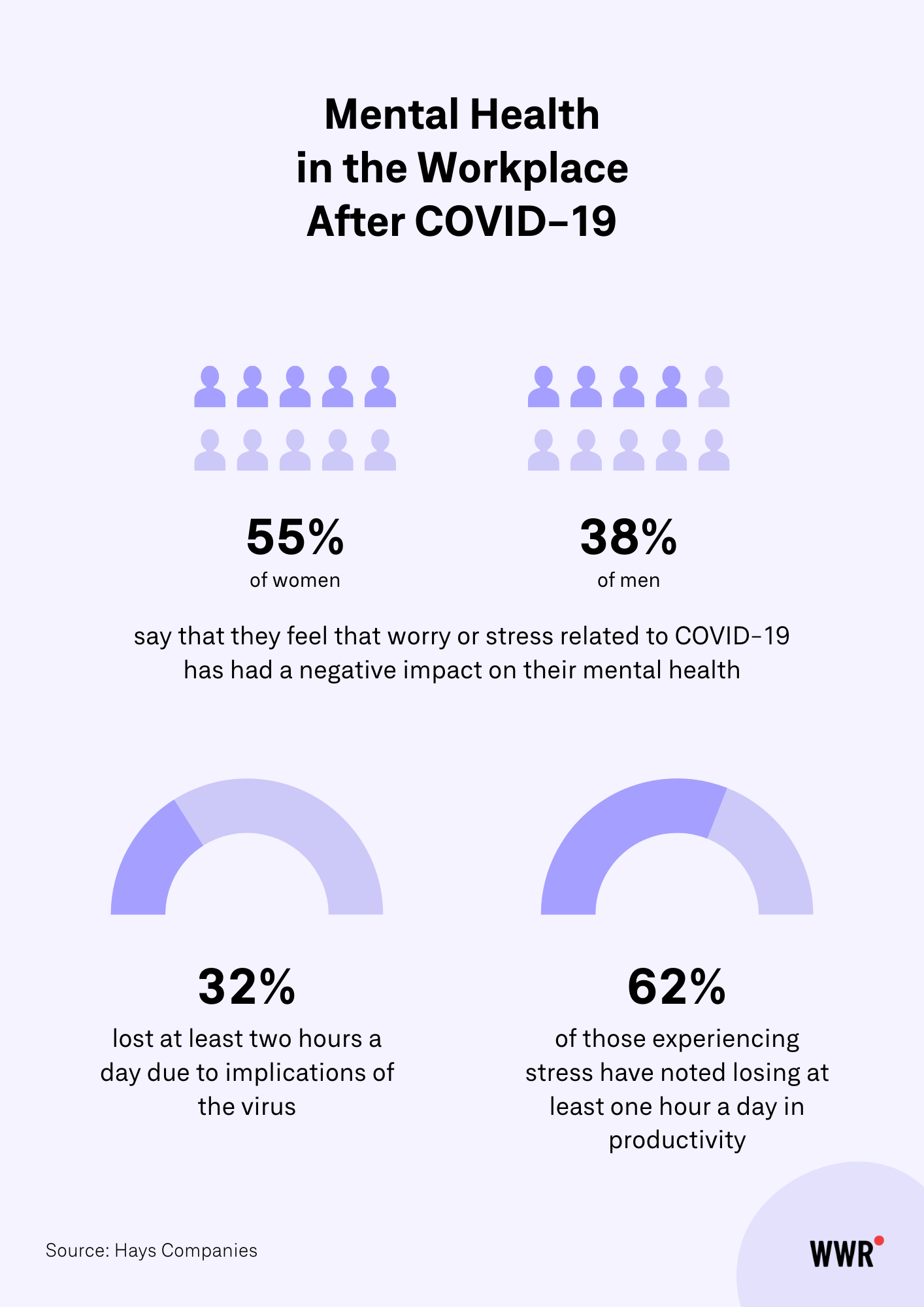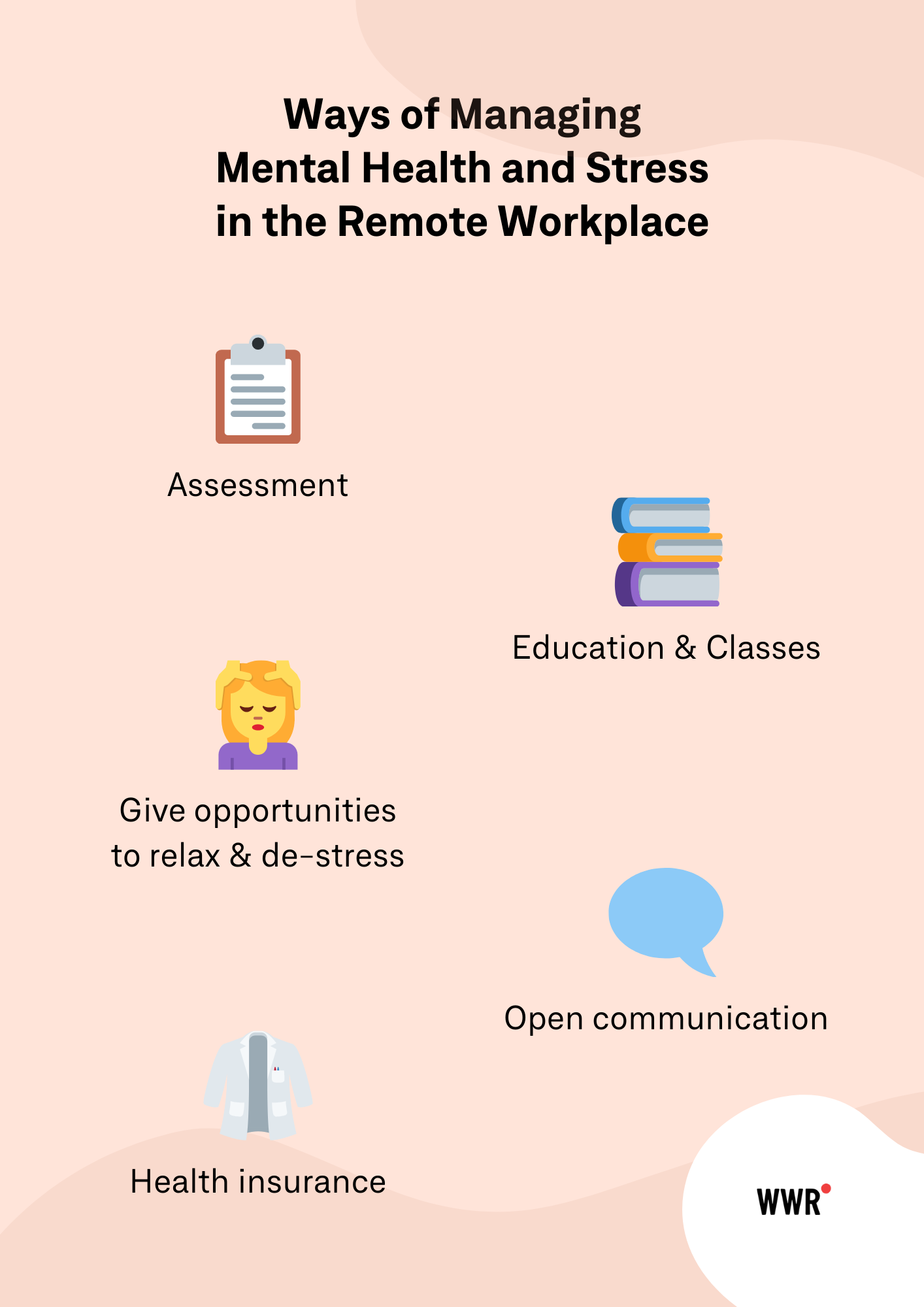How Remote Companies Can Support Mental Health in the Workplace

How does your remote company support mental health in the workplace?
If you don’t have a clearly defined mental wellness plan, you’re already behind.
Mental health issues such as stress, anxiety, and depression negatively affect your organization’s success. And after COVID-19, these may only be getting worse.
To keep your remote workers happy, engaged, and healthy, we’re going to highlight 10 ways your company can support mental health in the workplace today.
And we’ll start with why this task matters so much:
The Importance of Mental Health in the Workplace
Is prioritizing your remote employees’ mental health worth the time, effort, and company resources? Absolutely.
According to research from the World Health Organization (WHO), an estimated 264 million people suffer from depression and anxiety.
Chronic workplace stress is one of the biggest contributors to depression. It may stem from risk factors in the workplace such as:
- Unclear tasks and responsibilities
- Poor communication and collaboration
- Limited control over one’s area of work
- Unsuitable tasks for one’s experience/competency
- Overburdened workload
- Unreasonable deadlines
- Lack of team cohesion / poor support from coworkers and higher-ups
- Inflexible work hours
- Bullying and psychological harassment
Depression then interferes with a person’s ability to complete job tasks and reduces cognitive performance about 35% of the time.
That may be because symptoms like fatigue, loss of motivation, frequent headaches, chronic pain, feeling overwhelmed, etc., all make showing up to work more challenging.

Your employee’s mental health has a direct impact on their:
- Job performance and productivity levels
- Interest and engagement with their work
- Communication and collaboration with coworkers
- Ability to concentrate and limit distractions
- Ability to accept feedback and adapt to change appropriately
And that’s why depression and anxiety in the workplace are estimated to cost the global economy $1 trillion per year in lost productivity. Yikes!
Can your business afford these? Because most can’t. And the situation has only gotten worse, thanks to the COVID-19 pandemic.
Mental Health in the Workplace After COVID-19
It’s probably no surprise that workplace stress skyrocketed during the onset of COVID-19. And since a return to “normal” hasn’t happened yet, many are still coming to terms with the fallout.
Recent surveys show that:
- 9 out of 10 employers admitted that the COVID-19 pandemic negatively affected the behavioral health of their workforce.
- Almost one billion people worldwide now struggle with a mental or substance-use disorder, a number that’s grown at least 50% as a result of the pandemic.
- Approximately 50% of Canadians say their mental health has worsened due to COVID-19.
- Over 70% of employees are feeling the burnout of “always being on” in a remote environment.

But despite these grim statistics, remote companies can make positive strides to create a healthier work environment and better support their teams.
The Benefits of a Positive Work Environment
Experts say for every $1 put into outstanding mental health services, organizations see a $4 return in improved health and productivity.
That’s because creating a positive work environment that supports mental health initiatives leads to:
- Higher productivity
- Lower absenteeism
- Improved engagement
- Greater loyalty and retention
- Better communication and collaboration
- Higher levels of empathy
All these perks prove remote employers who aim to reduce stress and help their employees better manage their stress levels will come out ahead in more ways than one.
10 Ways Remote Companies Can Support Mental Health in the Workplace
Everyone in your company must be committed to supporting mental health in your remote workplace -- from key stakeholders and the C-suite down to your managers and team leaders.
So start brainstorming a game plan to implement these tips:
1. Create a Culture of Mental Health Awareness
Workplace mental health programs have proven successful when it comes to improving your employees’ emotional and physical well-being.
These programs not only educate employees but also help reduce the stigma and fear of talking about these issues.
Let employees know that you’re committed to a better, healthier workplace. Start sharing information about the signs and symptoms of burnout, where to get help and support, and tips they can utilize when they’re feeling stressed.

Infographics, monthly emails, quick videos, podcasts, etc., that discuss the prevention, early identification, and ongoing support for mental health issues will be invaluable for those silently struggling behind their screens.
2. Foster an Open, Non-Judgmental Safe Space
Companies whose leaders have been open about their own mental health struggles actually help encourage their employees to share their feelings and experiences with their teams.
While your employees may be less inclined to open emails from HR about mental health, they’ll certainly tune into C-suite communications about their own challenges.
This will help normalize conversations about mental health.
Try to equip your management team with a mental health toolkit. They should have all the resources, knowledge, and skills to recognize and respond to red flags in their employees.
When your employees feel empowered to speak up about negative workplace issues, your managers should be open and empathetic to their concerns. And they should know how to resolve the problems they have control over.
3. Make Everyone Aware of Mental Health Services In Your Health Insurance and Employee Assistance Program (EAP)
Does your company offer its employees health insurance with no or low out-of-pocket costs? Does it include coverage for mental health services and associated medications?
Access and expense are two big roadblocks that prevent employees from seeking help when they’re in a bad place. So make sure your coverage includes individual and couples counseling as well as family and group therapy at the lowest costs.
You’ll also want to broadcast the benefits of your employee assistance program (EAP). These employer-sponsored benefit programs help employees navigate personal issues that may be affecting their work lives.
Remind your employees that they can talk to qualified mental health experts -- completely free of charge and confidential.
4. Provide Employees with Self-Assessment Tools To Help Them Gauge Their Mental Health
You can send self-assessment tools and surveys to your employees every month, quarter, or when a significant change occurs (like getting a new supervisor or role). These can provide more insight and help them find ways to cope with their feelings.
You can take this one step further by using these anonymous surveys as a snapshot of mental health in your workplace. When you hear what’s stressing out your employees, you can address those issues and implement more effective stress management programs.
You may even want to connect these well-being metrics with your performance targets to see how your organization’s initiatives are impacting its overall goals.
5. Prioritize a Healthy Work-Life Balance
Even though your remote employees may not be tracking their time, managers should pay close attention to who’s burning the midnight oil and always be the first to respond to messages.
So you may want to:
- Allow mental health days and flexible schedules. Let your employees have one day a week or biweekly to disconnect -- without counting against their vacation days.
- Practice asynchronous communication, so employees don’t feel pressure to be “on” 24/7.
- Call out employees who don’t use their vacation days. These employees shouldn’t feel as if they can’t get away to relax in unplugged bliss. Strongly encourage them to take off, and they’ll return feeling better and more productive than ever.
- Make time for social connections during the workday. Water cooler Slack chats, virtual coffee dates and happy hours, monthly movie nights, etc., all help relieve stress as a team. Coworkers create positive emotional experiences that help build bonds and boost remote collaboration.
Your employees need time away from work to rest, recharge, and connect with their loved ones and hobbies. This helps replenish their mental stores, so they’re not on the verge of burning out.
6. Be Transparent and Involve More Employees In Decision-Making
When employees feel as if they have no control, they’re more prone to feelings of helplessness, stress, and anxiety. So if you can encourage team leaders to include more employees in key decision-making meetings, you may give them a greater sense of control and direction.

Employees who feel like their participation and contributions matter may be more confident and excited to show up to work each day.
7. Offer Free Professional and Personal Development
Personal development helps catapult careers and makes employees more loyal. Plus, as your employees increase their skills, your company gets to benefit from all their newfound knowledge. That’s a true win-win!
So consider offering:
- Lifestyle coaching and self-management programs, which give employees the tools they need to set goals, manage their work and personal lives, and control their stress levels.
- Professional development courses to help them advance in their careers. There are tons of free online classes and courses to use here.
- Lunch and learn sessions, where employees can listen to speakers or take a webinar while they munch on lunch in 30 to 60 minutes.
Each of these programs will show that your company is invested in its remote employees. And that’s a must-have ingredient for a healthy workplace.
8. Always Show Recognition and Gratitude
Showing recognition and gratitude for your employees is an essential part of learning how to build a strong culture with a remote team.
When employees feel valued and their contributions are recognized, they’ll believe the work they do really matters to the organization's success. This will boost motivation and confidence while easing feelings of stress and anxiety.

To do this, you may want to:
- Start every meeting with a moment of gratitude and reflect on the positive contributions made by your team.
- Develop a system for recognition, like an employee-of-the-month. Encourage your managers to give kudos to employees who went the extra mile.
- Surprise employees with a delivered care package to show how much you appreciate them. Fill this with swag, baked goodies and treats, fun gift cards, etc.
These steps will help employees feel as if their hard work isn’t being taken for granted.
9. Make Holistic Wellness a Priority
Holistic well-being encourages better mental health. And stronger mental health leads to happier, more productive teams.
So your company may want to:
- Host wellness workshops that teach employees stress management tools, breathing exercises, and guided relaxations.
- Encourage mid-day meditation. Giving employees the time and space to practice mindfulness will help lower stress and anxiety while increasing focus and motivation.
- Make room for healthy habits. Consider offering your employees additional benefits like a free gym membership, yoga classes, stipends for healthy meal delivery services, and access to sleep coaches. Figure out ways to “gamify” these activities and incentivize those who partake in them.
Your employees may be in a better headspace as a result of these offerings, and that means they’ll be able to create, contribute, and collaborate more productively.
10. Get Tech On Your Side
There are dozens of free and paid apps and subscriptions to help your remote company foster better mental health. Give your employees access to these tools, and they’ll feel empowered to manage and reduce their stress and anxiety on their own.
A few of our favorites include:
- Starling, which delivers mental health assessments, ongoing therapy and self-help tools, educational videos, and unlimited support 24/7.
- Talkspace, the #1 rated online therapy platform.
- Aura Health, an app that helps your employees improve their emotional well-being with expert life coaches and therapists. They’ll learn about sleep hygiene, emotional intelligence, and more.
- Breethe. Touted as “the friendliest wellness app” out there, this app makes meditation and mindfulness easily fit into everyday life.
You could also ask your employees to submit their ideas for tools/apps they’d like to use too.
Takeaway On Promoting Mental Health in the Workplace
Focusing on mental health in the workplace is essential to taking care of your employees, as you’ve seen today.
But there’s no one-size-fits-all approach to keeping your remote employees happy and healthy. So you’ll need to experiment with a few of today’s ideas to see what really resonates with your team.
Start by addressing the biggest stressors your employees report in the workplace. Then come up with a game plan to reduce these and encourage better self-care. Your organization and its exceptional employees will be in a much better place as a result.